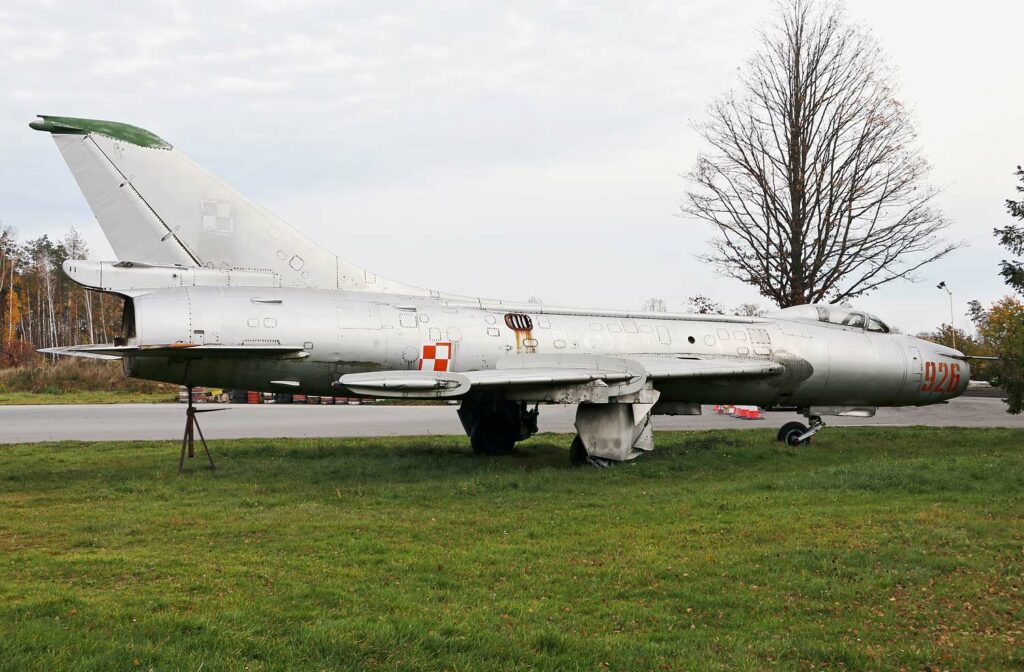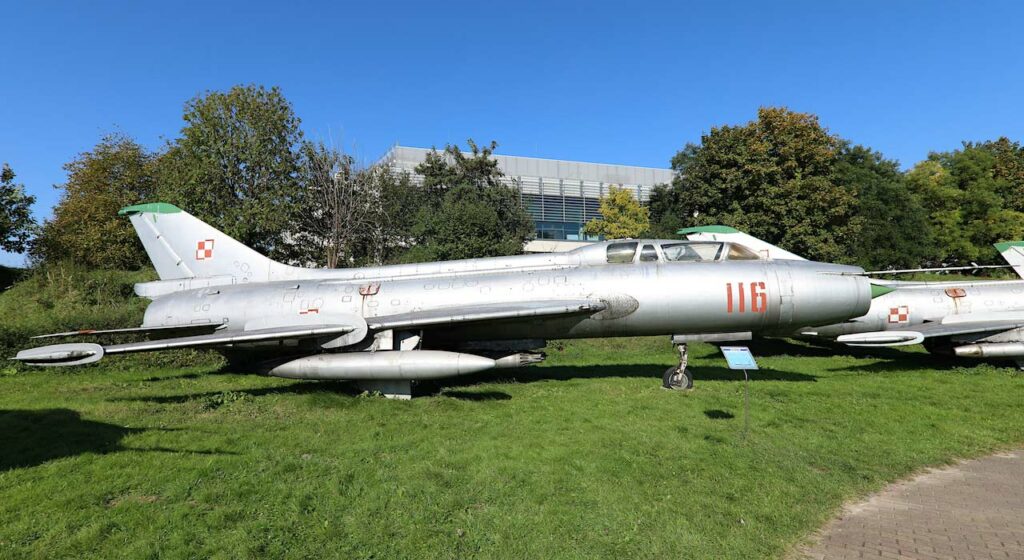The Sukhoi SU-7, named FITTER A, was a Soviet-era, supersonic jet fighter-bomber, known for its speed and ground-attack capabilities.
Technical Summary
The Sukhoi Su-7, NATO designation “Fitter A,” was a single-seat, supersonic fighter-bomber developed by the Soviet Union in the late 1950s. Designed primarily for ground-attack missions, it was one of the first Soviet aircraft capable of reaching supersonic speeds in level flight. Equipped with a Lyulka AL-7 turbojet engine, it featured swept wings and a robust airframe to withstand high-speed, low-altitude operations. The Su-7 was versatile, capable of carrying a variety of weapons, including bombs, rockets, and missiles. Despite its limited range and heavy fuel consumption, the Su-7 was a cornerstone of Soviet and allied air forces, serving in various conflicts and roles until its eventual replacement by more advanced models.

In brief
The development of the Sukhoi Su-7, known as “Fitter A” by NATO, began against the backdrop of the Cold War, a period characterized by rapid advancements in military aviation technology and an arms race between the Soviet Union and the Western bloc. The Soviet Air Force needed a versatile, high-speed aircraft capable of performing both air superiority and ground-attack missions in response to evolving battlefield requirements and the emergence of NATO’s advanced fighter jets.
Launched by the Sukhoi Design Bureau in the mid-1950s, the Su-7’s development was spearheaded by Pavel Sukhoi. The aircraft first flew on September 7, 1955, marking a significant milestone in Soviet aviation. The “Fitter A” nickname, assigned by NATO, reflects the aircraft’s role and capabilities, emphasizing its ground-attack specialization.
Design
The Sukhoi Su-7’s design was a product of its time, emphasizing speed, agility, and ground-attack capabilities. It featured a swept-wing configuration, optimized for supersonic flight, and was powered by a single Lyulka AL-7 turbojet engine, capable of propelling the aircraft to speeds exceeding Mach 2. The Su-7’s airframe was constructed to endure the stresses of low-altitude, high-speed flight and ground-attack missions, incorporating reinforced structures and armor to protect the pilot and critical systems.
Measuring 18.3 meters (60 feet) in length, with a wingspan of 9.31 meters (30.5 feet), the Su-7 was designed for simplicity and durability. Its landing gear was rugged, allowing operations from less-prepared runways, a crucial feature for forward-deployed units. However, the design also had drawbacks, including a relatively short operational range and heavy fuel consumption, which limited its loiter time over the battlefield.
The Su-7 introduced several innovations to Soviet aircraft design, including an early form of variable air intake geometry to optimize engine performance across a wide range of speeds and altitudes. Despite its shortcomings, the aircraft’s robust design and versatility made it a valuable asset for the Soviet Air Force and its allies.
Performance
The performance of the Sukhoi Su-7 was impressive for its time, reflecting the Soviet emphasis on developing capable and adaptable military aircraft during the Cold War. Powered by the Lyulka AL-7F-1 turbojet engine, which produced up to 67 kN (15,000 lbf) of thrust, the Su-7 could reach a maximum speed of Mach 2.0 (2,230 km/h or 1,385 mph) and attain a service ceiling of 17,600 meters (57,740 feet).
Its combat radius was approximately 300 kilometers (186 miles), with a maximum ferry range of 1,650 kilometers (1,025 miles) with external fuel tanks. These performance metrics, while competitive, highlighted the Su-7’s limitations in range and endurance compared to its Western counterparts, such as the American F-105 Thunderchief, which had a greater range and payload capacity.
The Su-7’s armament included a pair of 30 mm NR-30 cannons and the ability to carry up to 2,000 kg (4,409 lbs) of external ordnance, including bombs, rockets, and tactical nuclear weapons, making it a formidable ground-attack platform. Its speed and payload capacity made it effective in its designated role, despite competition from more advanced aircraft over its operational lifespan.
Variants
The Sukhoi Su-7 series saw several variants throughout its service life, each designed to enhance the aircraft’s capabilities or adapt it to specific roles. Key variants included:
- Su-7B: Improved ground-attack capabilities with increased fuel capacity and upgraded avionics.
- Su-7BM: Featured an upgraded AL-7F-1 engine for better performance.
- Su-7BKL: Adapted for rough field operations with skid landing gear and additional armor.
- Su-7BMK: Export version of the Su-7BM, widely used by Soviet allies.
- Su-7U: A two-seat training variant, providing operational conversion training for pilots.
Each variant reflected ongoing efforts to address the Su-7’s limitations and expand its operational flexibility, showcasing the adaptability of the design to different requirements and environments.

Military Use and Combat
The Sukhoi Su-7 saw extensive military use, particularly in conflicts involving Soviet allies. It was deployed in significant numbers during the Six-Day War (1967), the Yom Kippur War (1973), and the Indo-Pakistani Wars, among others. Its primary role was as a ground-attack aircraft, where its speed and payload made it effective against ground targets, despite being vulnerable to anti-aircraft defenses and enemy fighters.
In combat, the Su-7 proved capable of delivering a variety of ordnance, from conventional bombs to unguided rockets, against enemy fortifications, troop concentrations, and other targets. Its performance in these conflicts demonstrated the strengths and weaknesses of the design, highlighting its effectiveness in strike missions but also its susceptibility to more modern air defenses and aircraft.
Compared to contemporaneous Western aircraft, the Su-7 was often outmatched in terms of avionics and weapons delivery accuracy. However, its ruggedness, speed, and adaptability ensured it remained a valuable asset in the arsenals of several air forces. Over time, the Su-7 was gradually phased out in favor of more advanced designs, such as the Su-17/20/22 series, which offered improved performance, greater range, and more sophisticated weapons systems.
Despite its retirement from front-line service, the Su-7’s legacy endures as a symbol of Soviet military aviation during the Cold War, representing a critical step in the evolution of fighter-bomber aircraft.
Technical Conclusion
The Sukhoi Su-7 (Fitter A) represents a pivotal moment in the history of military aviation, embodying the transition to supersonic speeds and specialized ground-attack capabilities during the Cold War. While it faced limitations in range and technology compared to Western counterparts, its speed, robustness, and versatility made it a formidable force in various conflicts. The Su-7’s development and operational history reflect the challenges and achievements of Soviet aircraft design in an era of rapid technological advancement and geopolitical tension. As such, it remains an important part of military aviation heritage, illustrating the evolution of airpower in the latter half of the 20th century.
Back to the Fighter Jet section.